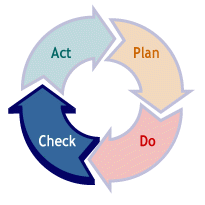Guide to Developing an Environmental Management System - Check
Background
Building an Environmental Management System (EMS) might sound like an overwhelming task for a smaller organization, but it need not be. Taken in steps, it is a job that small and medium-sized organizations can tackle. These pages will take you through basic steps as they are outlined in the 2001 Second Edition of Environmental Management Systems: An Implementation Guide for Small and Medium Sized Organizations. This page pulls out particular steps from the "Check" section of the Guide, and points back to specific pages in the guide to fill out worksheets and get additional materials.
Check: Checking, including monitoring and corrective action
As discussed earlier, it is recommended that your EMS be built on the "Plan, Do, Check, Act" model to ensure that environmental matters are systematically identified, controlled, and monitored. Using this approach will help to ensure that performance of your EMS improves over time and that you meet your goals for implementing an EMS in the first place.
This stage continues the step-by-step action plan for developing and implementing the elements of an EMS. By this time, you should have sufficient EMS processes in place to begin to "check" your EMS. One approach is discussed below. 
Conduct Internal EMS Audits
Once internal auditors have been selected and trained, you should design and initiate the internal auditing process. At this point, you should have sufficient EMS processes in place to conduct meaningful audits. Many organizations find that it is easier to start with smaller, more frequent audits than to audit the entire EMS at once. These early audits can serve as a learning tool. Audit records should be managed in accordance with the records management process. Once the audit results are known, use the corrective and preventive action process to address any identified problems.
